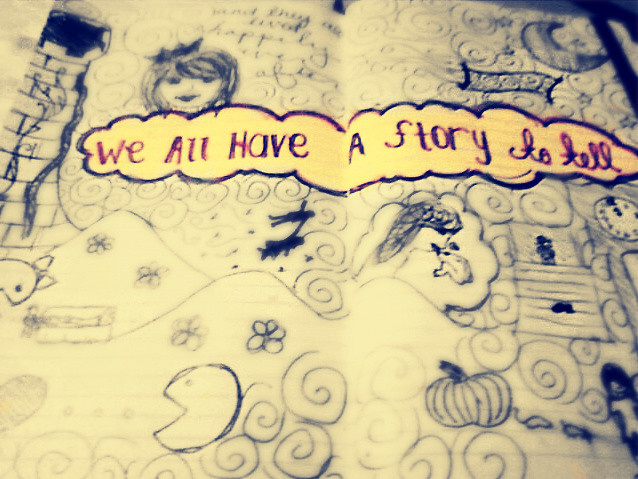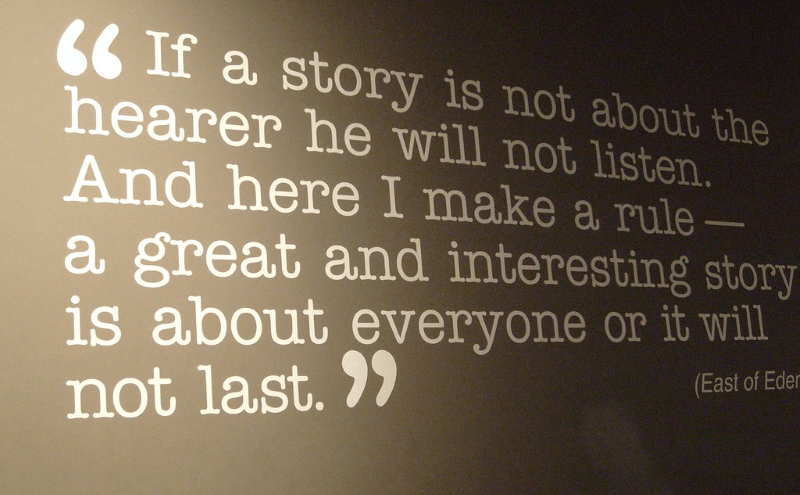Win Your Customers’ Hearts with Storytelling
People have been telling stories since we could draw on cave walls. Bedtime stories, grand odysseys, tall tales, epic adventures, tragedies, romances, comedies – these are how we understand one another, how we bond with each other.
Stories are how smart marketers win their customers’ hearts.

Selling isn’t just about the cool things your product can do, and buying isn’t a logical process. Stories bridge the gaps between features and benefits and the deep emotional reasons people buy. Stories build connections between you and your prospects – emotional connections that keep them coming back to you.
Consider your favorite blogs and the most memorable commercials. They used the art of storytelling to bypass your logical mind and put their message straight in your heart. Whether you laughed, cried, hated the product, or rushed out to buy it, the stories stuck in your mind and kept you coming back for more.
Clearly, stories are powerful tools for content marketers.
So how do you use the art of storytelling to win your customers’ hearts? First, you have to know what makes a good story. Next you apply some practical tips to refine your stories. And then you use them in the right places to build those connections with your audience.
What makes good storytelling?
Good stories – the ones you remember because they captivated you – use all the right elements in the right proportions. The right combination
- captures your attention
- keeps you interested
- draws you in
- resonates with you
- builds a bond between you and the storyteller
The Elements of Every Good Story
Action or Conflict
Something happens.
Either the character does something, or something happens to the character in the story. All good stories have some sort of conflict. Even when the conflict is emotional or logical, action will stem from it depending on how the characters of the story choose to act.
Where there’s conflict, readers naturally want some sort of resolution. A nice tidy ending feels good, but it’s not always necessary to a good story, or to fulfilling the purpose behind the story. In fact, sometimes leaving your audience hanging a little bit is a good thing. It keeps them interested and coming back for more, something TV show writers and novelists understand and take advantage of.
Character
Some personality is involved in the action.
Human, animal, protagonist, bad guy – every story revolves around at least one character. Most memorable stories stick in our minds because of the characters involved. Some we love and want to succeed, while others we love to hate.
Strong characters are crucial to content marketers’ storytelling because they are the connection between storyteller and audience. The more your audience can relate to the character, the more they see themselves in that person’s shoes.
If that person is a satisfied customer, prospects begin to think you could help them, too.
If the person in the story is you, readers get to know, like, and trust you. And they won’t easily forget who you are, either.
- First-person:
In this point of view, the character is yourself (“I said”). A great example is a very successful 1920s ad from legendary copywriter John Caples designed to sell at-home music courses: “They Laughed When I Sat Down at the Piano But When I Started to Play!” This headline and half the ad space presents the story as a personal triumph to overcome objections and spark desire for the product.
- Second-person:
The character in this point of view is your audience (“You say”). Second-person stories often use words like “imagine” to get the reader thinking the way you want them to. A perfect recent example is this story from Copyblogger about kicking down creativity’s door.
- Third-person:
These stories focus on a third-party either fictional or true (“He said”). Case studies about customers who have successfully used your product or service are a great example of third-party characters. So are introductions about people you’re interviewing.
Emotion
Feelings of the character and the emotional response of the reader.
While action drives the story and characters build connections, emotion gives the story power. People buy for deep, un-logical, emotional reasons. The more powerful your story’s emotion is, the more likely your prospects and customers are to do something. When a story resonates with us, we naturally want to do something about it, such as retell the story to others or buy the author’s next book. Pack your stories with emotion, and your customers will do something about what they feel, too – like comment, share, subscribe, open, click, or buy.
- Feelings of the character:
Emotionless characters are usually boring. And if the character has no emotional response to what’s happening in the story, why should your audience care enough to feel anything? This doesn’t mean you have to explicitly state what the character feels, but it should be obvious by what the character does and how he speaks that he feels something. In Caples’ music course ad, the character feels pride at his accomplishment; in the story about kicking down creativity’s door, the character is determined.
- Emotional response of the reader:
If you aim to win your customers’ hearts with the art of storytelling, you have to elicit some sort of emotional response. The most common emotions to capitalize on are:
- fear
- survival or salvation
- greed
- exclusivity
- anger
- flattery
- guilt
Imagery
Details that paint a picture in your audience’s minds.
Imagery is what makes the story come alive. It’s the specific details that make a story real, believable, and memorable. The more believable the story is, the more invested the reader becomes, so she feels the emotional response more acutely. And if your readers remember the stories you tell, they’ll remember you better, too. So you’ll be top of mind when they have a problem or need you can help them with.
Details and imagery also quickly convey the best benefits of what you offer, especially the emotional roots of why customers buy from you. They can even demonstrate how to use your offer without losing your prospects in logistics.

Practical Tips to Use Storytelling to Win Customers Over
Stories are generally easier to use in long-form content–think videos, blog posts, ebooks, case studies, white papers, or brochures – but tight, concise stories can be effective in short formats, too. Either way, the trick to making your storytelling work is to choose the right story, and make it as powerful as possible.
How to Choose the Right Story
Pick a story that fits the length of your format. If you have a small ad or short video, the best story to use may have a small conflict or only a little action.
Choose a story with a character that appeals to your audience. Readers that connect with the protagonist are more likely to believe you understand them and can actually help them.

Make sure the action/conflict of the story fits your customers’ problems, needs, or stage of the buying cycle. This reinforces the idea that you can help your audience, and shows the use and benefits of your offer.
Choose a story that stimulates the emotions that drive your prospects to take a desired action. For example, dentists trying to get more past patients to come in for check-ups might tell stories about how one patient’s timely visit caught a problem before it became a major disaster. A story like that could capitalize on fear (of pain, expense, surgery, etc.) to encourage patients to come in.
How to Make Your Storytelling As Powerful As Possible
- Use specific details.
If that story about the patient’s timely visit only said how she was able to avoid a major (but unspecified) problem, it would be bland, boring, forgetful. It would make no impact at all. On the other hand, if the dentist talked about specific things like deep cavities, abscesses, root canals, the cost of one check-up versus the cost of surgery and multiple follow-up visits – the story suddenly becomes much more interesting and powerful.
- Make it personal.
Remember that piano-playing ad Caples wrote in the first-person? Part of why it was so successful was that personal triumph. People respond better to personalized content because it helps them get to know, like, and trust you. When telling stories from the second-person (“you”) and third-person (“he”) point of view, make them more personal by making sure you really understand your audience’s struggles and frustrations, and telling the story in a way that shows you empathize and relate with them.
- Keep it sharp, clear, and concise.
Even long stories benefit when you pare them down to the most important points. This keeps you from wandering off on a tangent, the action of the story moving along at a good pace (which maintains your audience’s interest), and it keeps the story in line with the purpose for sharing it in the first place.

Where to Use the Art of Storytelling
Stories can be employed in nearly every marketing or promotional material you create, because they add interest and build an emotional bond with your audience – both necessary to win their attention and eventually their purchasing power. Here are some ideas of where you can use stories to build relationships with your prospects and earn their loyalty.
- Blogs
Of all these options, blogs are perhaps the most naturally suited to storytelling. They’re designed to keep visitors coming back for more as you publish fresh content. Stories increase engagement and spark deeper interest, making visitors want to come back for more than just helpful how-to’s.
A prospect’s e-mail inbox is still the most personal way for you to reach them. Personalized e-mails full of interesting stories and valuable content teach your subscribers to open your e-mails and click through, while helping them get to know you. Plus, e-mails with stories don’t feel like mass messages (even though most subscribers know they are).
- Videos
Visual content takes storytelling to the next level by allowing you to add elements like setting and sound. Videos can also feel a lot more personal if you appear in or narrate the video.
- Podcasts
Like videos, podcasts are more personal and allow you to add the extra storytelling element of sound. Because listeners only have your voice–no words to read or images to watch – using stories is even more important to keep their interest, teach concepts (especially abstract ones), and be memorable.
- Case Studies & Success Stories
As marketing collateral, it’s easy for these to be bland and boring. Emphasizing the story behind the success – not just how someone used your product or service, but who and why – turns a case study into something your audience actually wants to read. It puts your offer in the best light possible and helps prospects relate to an existing customer. That gets them thinking, “If they can help that guy, they can probably help me.”
- Interviews
You have to introduce the interviewee to your audience anyway, so why not use a story to help them get to know this new person and understand why you’re interviewing him? A story about an entrepreneur’s rise to fortune is so much more captivating than simply saying your guest has founded so many businesses and earns so much per year.
How do you use the art of storytelling? Which stories resonate the most with you or your customers? We’d love to hear your thoughts!

Comments (0)